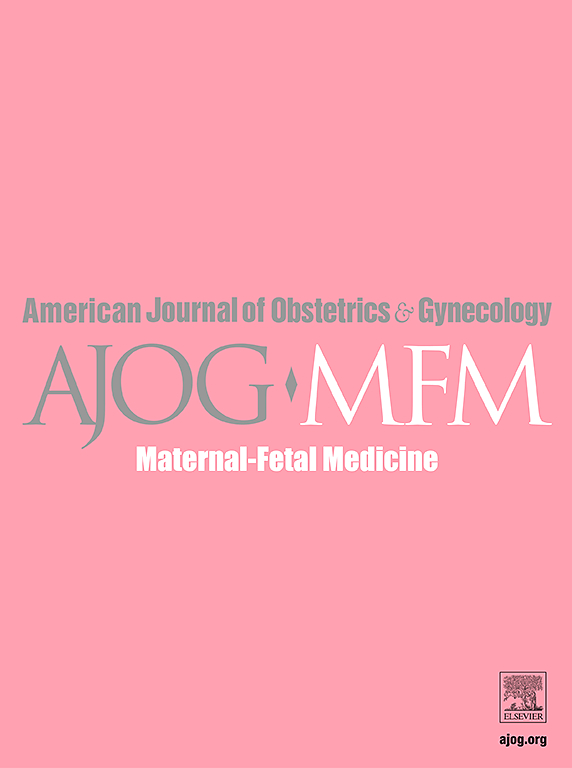Association between distance traveled and abortion consideration and completion among people with fetal myelomeningocele
IF 3.8
2区 医学
Q1 OBSTETRICS & GYNECOLOGY
American Journal of Obstetrics & Gynecology Mfm
Pub Date : 2025-02-04
DOI:10.1016/j.ajogmf.2025.101631
引用次数: 0
Abstract
Background
Due to the small number of centers performing maternal-fetal surgery for fetal myelomeningocele, many people are required to travel significant distances for perioperative counseling at an experienced center. As part of the decision-making process for the management of myelomeningocele, some pregnant individuals are interested in, and may ultimately proceed with, termination of pregnancy. Additional travel for abortion care may compound psychological and financial burdens for pregnant individuals, given the existing barriers to accessing abortion care across the United States.
Objective
The objective of this study was to evaluate the association between the distance traveled to a fetal care center and the consideration and completion of abortion among patients with fetal myelomeningocele.
Study design
We performed a retrospective cohort analysis of all singleton myelomeningocele consultations at a single fetal care center in Illinois from 2018 to 2024. The exposure was the distance traveled to the fetal care center defined as miles from the patient's zip code of residence to the fetal care center. Distance was analyzed in two ways: categorically (dichotomized based on median value) and continuously. The primary outcomes were abortion consideration, ascertained by a nurse during fetal care center intake, and abortion completion. Bivariate and multivariate log-binomial regression analyses were performed. A subgroup analysis was performed by participant state of residence. Statistical significance was considered P<.05.
Results
There were 133 participants available for the abortion consideration analysis and 157 participants for the abortion completion analysis. Median distance traveled was 39 miles (IQR 15-116 miles). People traveling below the median distance were more likely to identify as Latinx, reside within Illinois, and present at an earlier gestational age when compared with those traveling above the median distance. Distance traveled was independently associated with abortion consideration, after controlling for gestational age at the time of presentation to the fetal care center (aRR 0.44, 95% CI 0.27–0.72). When treating the distance traveled as a continuous outcome, for every mile traveled the risk of considering abortion decreased by 1% (aRR 0.99, 95% CI 0.98–0.99). On subgroup analysis, this finding was persistent only among individuals living in Illinois. There was no significant relationship between the distance traveled to the fetal care center and abortion completion.
Conclusions
Increased distance traveled is associated with a lower risk of abortion consideration among individuals presenting to a fetal care center for fetal myelomeningocele consultation. These data emphasize the nuanced relationship between fetal diagnosis and abortion and the importance of providing comprehensive reproductive counseling to patients seeking consultation at a fetal care center.

脊髓脊膜膨出患者的路程与流产考虑和流产完成的关系。
背景:由于开展母胎手术治疗胎儿脊髓脊膜膨出的中心较少,许多人需要长途跋涉到经验丰富的中心进行围手术期咨询。作为髓脊膜膨出管理决策过程的一部分,一些孕妇对终止妊娠感兴趣,并可能最终进行终止妊娠。考虑到在美国各地获得堕胎护理的现有障碍,额外的堕胎护理旅行可能会加重孕妇的心理和经济负担。目的:本研究的目的是评估到胎儿护理中心的路程与胎儿脊髓脊膜膨出患者考虑和完成流产之间的关系。研究设计:我们对2018-2024年伊利诺伊州一家胎儿护理中心的所有单胎脊髓脊膜膨出咨询进行了回顾性队列分析。暴露量是到达胎儿护理中心的距离,定义为从患者居住地到胎儿护理中心的英里数。距离分析有两种方式:分类(基于中位数的二分类)和连续。主要结局是考虑流产,由一名护士在进入胎儿护理中心时确定,流产完成。进行了双变量和多变量对数二项回归分析。按参与者居住州进行亚组分析。p < 0.05认为有统计学意义。结果:有133名参与者可用于流产考虑分析,157名参与者可用于流产完成分析。平均行驶距离为39英里(IQR 15-116英里)。与路途中位数距离以上的人相比,路途中位数距离以下的人更有可能被认定为拉丁人,居住在伊利诺伊州,并且胎龄更早。在控制到胎儿护理中心时的胎龄后,行走距离与流产考虑独立相关(aRR 0.44, 95% CI 0.27-0.72)。当将行进距离作为连续结果时,每行进1英里考虑流产的风险降低1% (aRR 0.99, 95% CI 0.98-0.99)。在亚组分析中,这一发现仅在居住在伊利诺伊州的个体中持续存在。到胎儿护理中心的路程与流产完成无显著关系。结论:在胎儿护理中心进行胎儿脊膜膨出咨询的个体中,旅行距离的增加与流产风险的降低有关。这些数据强调了胎儿诊断和流产之间的微妙关系,以及向在胎儿护理中心寻求咨询的患者提供全面生殖咨询的重要性。
本文章由计算机程序翻译,如有差异,请以英文原文为准。
求助全文
约1分钟内获得全文
求助全文
来源期刊

American Journal of Obstetrics & Gynecology Mfm
Medicine-Medicine (all)
CiteScore
7.40
自引率
3.20%
发文量
254
审稿时长
40 days
期刊介绍:
The American Journal of Obstetrics and Gynecology (AJOG) is a highly esteemed publication with two companion titles. One of these is the American Journal of Obstetrics and Gynecology Maternal-Fetal Medicine (AJOG MFM), which is dedicated to the latest research in the field of maternal-fetal medicine, specifically concerning high-risk pregnancies. The journal encompasses a wide range of topics, including:
Maternal Complications: It addresses significant studies that have the potential to change clinical practice regarding complications faced by pregnant women.
Fetal Complications: The journal covers prenatal diagnosis, ultrasound, and genetic issues related to the fetus, providing insights into the management and care of fetal health.
Prenatal Care: It discusses the best practices in prenatal care to ensure the health and well-being of both the mother and the unborn child.
Intrapartum Care: It provides guidance on the care provided during the childbirth process, which is critical for the safety of both mother and baby.
Postpartum Issues: The journal also tackles issues that arise after childbirth, focusing on the postpartum period and its implications for maternal health. AJOG MFM serves as a reliable forum for peer-reviewed research, with a preference for randomized trials and meta-analyses. The goal is to equip researchers and clinicians with the most current information and evidence-based strategies to effectively manage high-risk pregnancies and to provide the best possible care for mothers and their unborn children.
 求助内容:
求助内容: 应助结果提醒方式:
应助结果提醒方式:


